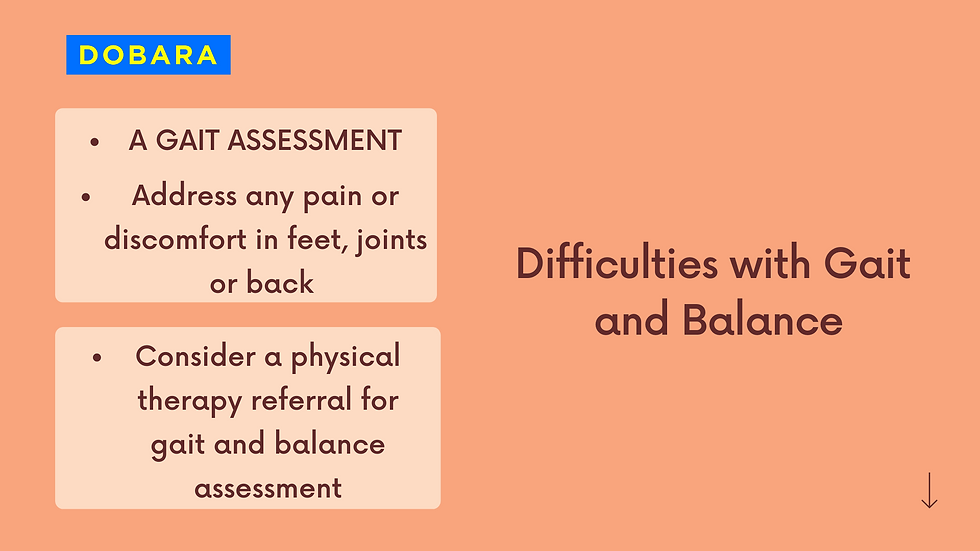Fall Prevention 101 for Seniors and Caregivers
- Mateen Ansari

- Jul 13, 2021
- 5 min read
On 10th July, 2021 U3A India invited Mateen Ansari, founder of DOBARA, to speak on the topic of Fall Prevention for Seniors and Caregivers.
Here is the video of the Zoom Presentation adapted for a Virtual format - From this session you will walk away with several helpful tools and guidelines on Fall Prevention, and of course with some practical homework for you to do at home along with a Fall Prevention To-Do List!
Here is a quick recap along with some of the highlights from the Presentation:

Initiating events involve extrinsic factors such as environmental hazards.
The majority of falls in the elderly population occur in or around seniors' homes.

Some well-researched intrinsic risk factors unique to each individual which increase the risk of falls are:


A fall can be described in four phases:
The first phase is an initiating event that displaces the body's center of mass beyond its base of support.
Initiating events could be a combination of both extrinsic and intrinsic factors I just mentioned such as :
-Environmental hazards;
- Joint pains, muscle weakness, and postural reflexes; &
-Last but not least the physical activity in progress at the time of the fall.
This phase is called the Pre-Landing Phase because it includes everything that happens prior to a fall. As far as Fall Prevention training goes this phase is easiest to train and helps prevent a fall.
Training strategies include:
Staying away from a sedentary life style and focus on Mobility,
Strength training
Balance exercises on a sustained basis – with regularity to keep one’s self strong and mobile to avoid unsteadiness and loss of balance.
Last but not least using common sense and not being too adventurous in taking risks!
The second phase is referred to as the ACTION & REACTION Phase of a fall.
It involves a failure of the intrinsic systems unique to each individual for maintaining upright posture such as
-Loss of sensory function,
- Impaired central processing,
- Muscle weakness
In the crucial seconds following the trip or stumble- your brain and body have to do some complex calculations in order to prevent the fall. If the displacement is detected and corrected in time – then the fall can be avoided.
How to recover from a stumble without sustaining a fall is something that professionals teach in the FALLS and BALANCE training sessions.
The third phase is an impact of the body on environmental surfaces, usually the floor or ground. In this Landing stage, how you land determines whether or not you will be injured from a fall.
For this there are training modules on how to fall correctly.
This might sound a bit funny, but it is important, we essentially have to arm ourselves with the right skills and knowledge so we can lessen the impact of a fall as we age.
PREVENT, PREPARE and PREVAIL - Our Fall Prevention Mantra!
The training here is focused on how to protect our head, neck and other bones which might be susceptible to fractures.
There is essentially a right way to fall.
If we’re going to fall, we might as well do it par excellence!!
A fourth phase, although not part of a fall, concerns the
-medical,
-psychological, and
-health care consequences of the fall and any injuries which arise from it.
These consequences affect the degree of damage and disability resulting from the fall. Approaches to preventing falls and their consequences should focus on factors related to each of these phases

Falls that don't cause an immediate injury can end badly If one does not know how to react.
Most seniors find themselves unable to get up after a fall.
It could be due to the shock, injury, stiff joints, weak muscles, or many other factors.
The first thing you need to do after a fall is to understand if you're hurt.
Take a few minutes to check your body for any pain or injuries, then: if you're not hurt, try to get up from the floor.
Now there is a researched technique for specific ways to get up after a fall


Now What If you cannot get up after a fall?
Try not to panic, reach out for the phone or emergency response button if you have on.
Try to slide towards an opening from where your voice can be heard, make a noise or yell.
Keep yourself as comfortable and as warm as possible
If it is do-able just roll away from damp areas
What can you do to be prepared in case you fall?
Make it a habit to carry cell phone on you
Or
An Emergency alarm device around your neck

Most older adults have difficulty getting up after a fall
Practicing in advance helps us be prepared for eventualities.
There is a Fall Recovery Training for Seniors, which focuses on improving strength and learning proper techniques that help you stand up independently.

A fall can be a sign of a new and serious medical problem that needs treatment, like a new illness, a urinary tract infection, or simple dehydration
Older adults who have fallen are at higher risk for a future fall- hence identifying and reducing fall risk factors, is extremely vital after a fall.
Busy doctors may not be thorough unless caregivers are proactive about asking questions.
Most doctors have the best intentions, but by questioning and interaction, caregivers can make sure that certain things aren’t overlooked (such as medications that worsen balance).

Here is a quick list of factors to be looked into after a fall – A CHEAT SHEET





To sum this up as we age, we need to be more aware that our homes and our lives need to age with us – this means that we need to make the requisite changes to our environments and our lifestyles so we can age in a healthy and active manner.
Our internal world as well as our external world have to evolve with us.
This may involve some home repairs or safety additions, adding lots of light to our surroundings, adding grab bars inside our bathrooms and toilets, removing all hazards like loose carpets, slippery floors or unstable shoes and chappals, even clothing that may hinder mobility.
And for your physical self, consider going for annual eye check ups, following a comprehensive strength and agility workout program, reviewing your medication, evaluate your risk for falling and supplementing your skillset with helpful fall prevention tools. Because the Good news is that most falls can be prevented by making a few adjustments to our lives and daily routines.
For the 60 and better we recommend an annual Assessment of:
Physical strength,
Muscle Strength
Flexibility and
Balance
Based on this assessment , the physical therapist will work with you to prevent falls, and this should be an ongoing process - not just reaching out to the Physiotherapist when in pain but in order to prevent the pain.


A Big Thank you to U3A India, Dr.P. Vyasamoorthy and Dr.R.K. Garg for organising this virtual event and for giving DOBARA a platform to talk about this very important topic of Fall Prevention. We look forward to more such senior wellbeing collaborations with you in the future!





very useful and excellent
sambandam jayakumar vice chairman, senior citizen bureau and u3a chennai
26/45 aspiran garden first st kilpauk chennai 600010 south india
093818 01446